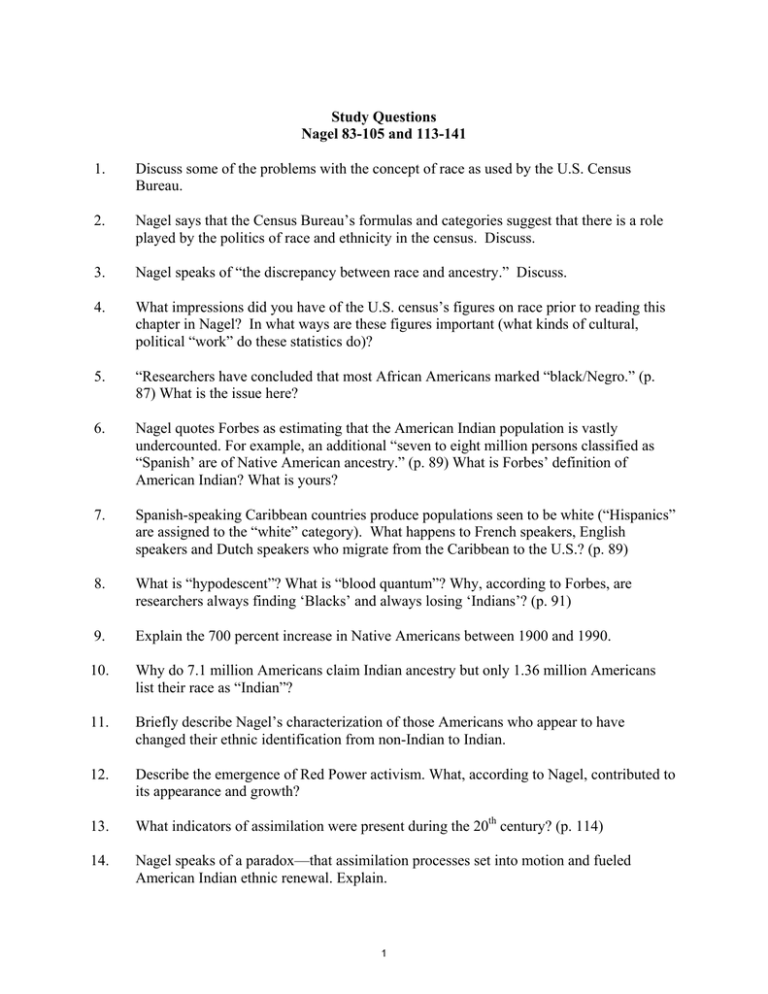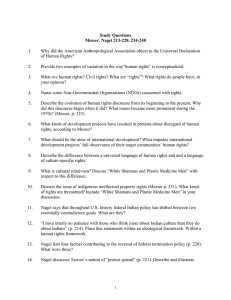Document 13359924
advertisement

Study Questions Nagel 83-105 and 113-141 1. Discuss some of the problems with the concept of race as used by the U.S. Census Bureau. 2. Nagel says that the Census Bureau’s formulas and categories suggest that there is a role played by the politics of race and ethnicity in the census. Discuss. 3. Nagel speaks of “the discrepancy between race and ancestry.” Discuss. 4. What impressions did you have of the U.S. census’s figures on race prior to reading this chapter in Nagel? In what ways are these figures important (what kinds of cultural, political “work” do these statistics do)? 5. “Researchers have concluded that most African Americans marked “black/Negro.” (p. 87) What is the issue here? 6. Nagel quotes Forbes as estimating that the American Indian population is vastly undercounted. For example, an additional “seven to eight million persons classified as “Spanish’ are of Native American ancestry.” (p. 89) What is Forbes’ definition of American Indian? What is yours? 7. Spanish-speaking Caribbean countries produce populations seen to be white (“Hispanics” are assigned to the “white” category). What happens to French speakers, English speakers and Dutch speakers who migrate from the Caribbean to the U.S.? (p. 89) 8. What is “hypodescent”? What is “blood quantum”? Why, according to Forbes, are researchers always finding ‘Blacks’ and always losing ‘Indians’? (p. 91) 9. Explain the 700 percent increase in Native Americans between 1900 and 1990. 10. Why do 7.1 million Americans claim Indian ancestry but only 1.36 million Americans list their race as “Indian”? 11. Briefly describe Nagel’s characterization of those Americans who appear to have changed their ethnic identification from non-Indian to Indian. 12. Describe the emergence of Red Power activism. What, according to Nagel, contributed to its appearance and growth? 13. What indicators of assimilation were present during the 20th century? (p. 114) 14. Nagel speaks of a paradox—that assimilation processes set into motion and fueled American Indian ethnic renewal. Explain. 1 2 15. What was the “Indian New Deal” legislation of 1934 (IRA)? What kind of politics did it emerge out of? What was the policy known as “termination” (1946-1960)? What kind of politics lay behind this legislation? 16. Describe the changes in American Indian communities that resulted from WW II. 17. Describe Indian renewal in urban areas. 18. Describe the social and political context of The Civil Rights Era. (p. 122) 19. How was the Bureau of Indian Affairs undermined during the 1970s and 1980s? 20. Was the occupation of Alcatraz Island a success or a failure? 21. A mother on a reservation came to refer to her son as “My son, the Indian.” What does this phrase allude to? Why is it funny? 22. Describe supratribal Indian identity. In what ways is this a “new” identity, a “new” ethnic group? In what ways not? 2 MIT OpenCourseWare http://ocw.mit.edu 21A.226 Ethnic and National Identity Fall 2011 For information about citing these materials or our Terms of Use, visit: http://ocw.mit.edu/terms.


